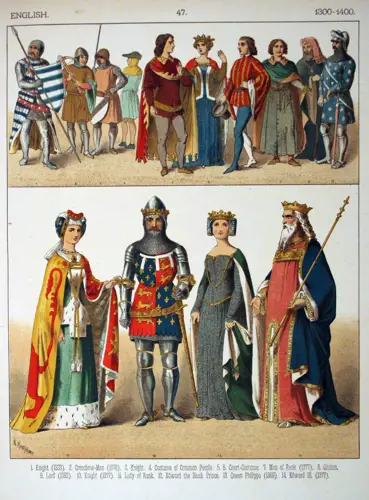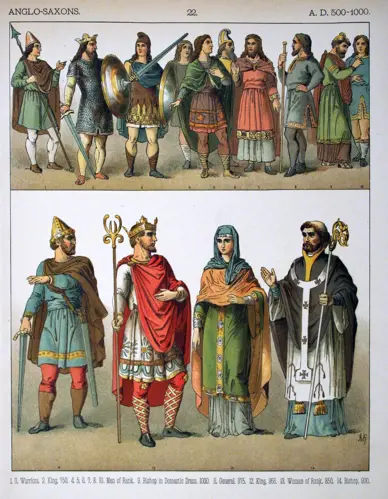Introduction to Medieval fashion for a Renaissance Faire
If you're looking for some ideas on how to dress for a Renaissance Festival, look no further! In this blog post, we will discuss the different types of medieval clothing that you can wear to these events. We will also provide some tips on how to put together your own outfit. So whether you're a newbie or a seasoned festival-goer, read on for some helpful advice!
What does "Medieval" mean?
Medieval and Medieval-like clothing is very popular for Renaissance Faires and similar events. Generally speaking, historians consider the years 470 AD and 1450 AD the Middle (Medieval) Ages. Most garb choices involve cultures and personas that are European in origin, so that is the focus of this article. However, there is a wealth of knowledge out there about other cultures in the time period including some lovely and exotic clothing. I will touch on the subject of other ethnicities during this time period at a later date. But now we will examine Middle Ages clothing that is European in nature, starting with the ladies.
A Woman's Medieval Wardrobe
 The foundation of a women's wardrobe at the time is the chemise or basic tunic. Some are fitted and other patters are the more voluminous sort with a drawstring at the neck line. Most people af the time were very limited in the amount of clothing they had and a plain chemise was an underlayer that could be easily and safely cleaned. The wealthy may have embroidery on them but not most. usually the fabric was white, off white, or beige. The average woman likely owned a chemise or two, an undergown with petticoat and perhaps an over gown of a better quality fabric for special events. It also was not uncommon for a woman to either marry while in an existing garment or recieve new a garment worn at the wedding and then after as a sort of formal wear. The white, stand-alone wedding gown, as we know it was only something that came into fashion in imitation of Queen Victoria of England's wedding dress until about four centuries later.
The foundation of a women's wardrobe at the time is the chemise or basic tunic. Some are fitted and other patters are the more voluminous sort with a drawstring at the neck line. Most people af the time were very limited in the amount of clothing they had and a plain chemise was an underlayer that could be easily and safely cleaned. The wealthy may have embroidery on them but not most. usually the fabric was white, off white, or beige. The average woman likely owned a chemise or two, an undergown with petticoat and perhaps an over gown of a better quality fabric for special events. It also was not uncommon for a woman to either marry while in an existing garment or recieve new a garment worn at the wedding and then after as a sort of formal wear. The white, stand-alone wedding gown, as we know it was only something that came into fashion in imitation of Queen Victoria of England's wedding dress until about four centuries later. The average Medieval woman had well made, serviceable clothing in colors meant to avoid soiling or damage in everyday life. Only the poorest of individuals did not wear hats. Most individuals had at least a basic coif. A coif is a unisex hat or underhat made of linen and fitted to the head. Women wore these in everyday life, farmers when out working, and soldiers under their battle armor. Often another hat was worn with it such as a helmet, flat cap or under henins (the very tall pointy hats that we often picture a princess in a castle wearing).Other hats worn at the time were hunter's caps (think Robin Hood hat), hoods and for the ladies a metal circlet around the head with a white veil pinned at the crown of the hair. Jewelry was a popular accessory but true finery was left for the noble and very wealthy. Many women had metal girdle belts that hung from the waist and down the front of the gown. Many women a chatalain attached to the belt. A chatelaine was a large sort of pendant which contained household keys and needlework supplies. Earlier in the era, sharp, quality needles might have been more difficult to afford and therefore the thrifty homemaker might be particularly interested in keeping track of them. There were veil pins to hold the diaphanous veils that were so popular, in place. As in all things the wealthy had theirs adorned with pearls or other valuable stones. For women their gowns tended to be of three styles: those that buttoned up, those that laced up and open sided over gowns that were more for appearance than functionality. Most gowns closed up the front via ladder lacing or a very small and precise row of buttons. Sleeves tended to be attached to the garment and very fitted, some even had buttons on the inside of the wrists so the sleeve could be unbuttoned to permit entry. There were some open,hanging 3/4 length sleeves as an option.
Many women had extremely long hair that was braided and styled to fit under headwear. Wealthy women might have hair pieces to create the styles they wished, if they lacked their own hair. Because bobby pins were unknown and pins in general valuable the practice of securing the hair with ribbons. They used a special tool they used to "sew" their hair in place using ribbon in the place of pins. These are all -small, inexpensive items that could add the last bit of historical accuracy. At Renaissance Faires floral crowns with trailing ribbons are a popular choice and i've yet to see a woman not flattered by one.
A Man's Medieval Wardobe
 For the Lords their clothing was much more basic. Linen breeches and hosiery, tunics, and hoods which were a sort of fitted half-cloak with an actual hood attached. Cloaks were common as well but not nearly as heavy or voluminous as we tend to think of them. They were light and easily portable for travel, much like a modern day windbreaker. Leather boots and simple shoes rounded out the outfit. For those of you with longer hair, it was not uncommon for men to wear their hair shoulder length or even and hoods were a unisex item and widely worn by women along with men. Towards the end of the era you see the birth of the codpiece...which will be further explained in the next blog entry.
For the Lords their clothing was much more basic. Linen breeches and hosiery, tunics, and hoods which were a sort of fitted half-cloak with an actual hood attached. Cloaks were common as well but not nearly as heavy or voluminous as we tend to think of them. They were light and easily portable for travel, much like a modern day windbreaker. Leather boots and simple shoes rounded out the outfit. For those of you with longer hair, it was not uncommon for men to wear their hair shoulder length or even and hoods were a unisex item and widely worn by women along with men. Towards the end of the era you see the birth of the codpiece...which will be further explained in the next blog entry. Final Thoughts
Renaissance Faires are a great place to show off your inner nerd while still getting some sun and enjoying the company of others. They can also be a great opportunity to get some new ideas for your next cosplay. With a little bit of creativity, you can put together a pretty convincing Renaissance outfit without spending a lot of money.


